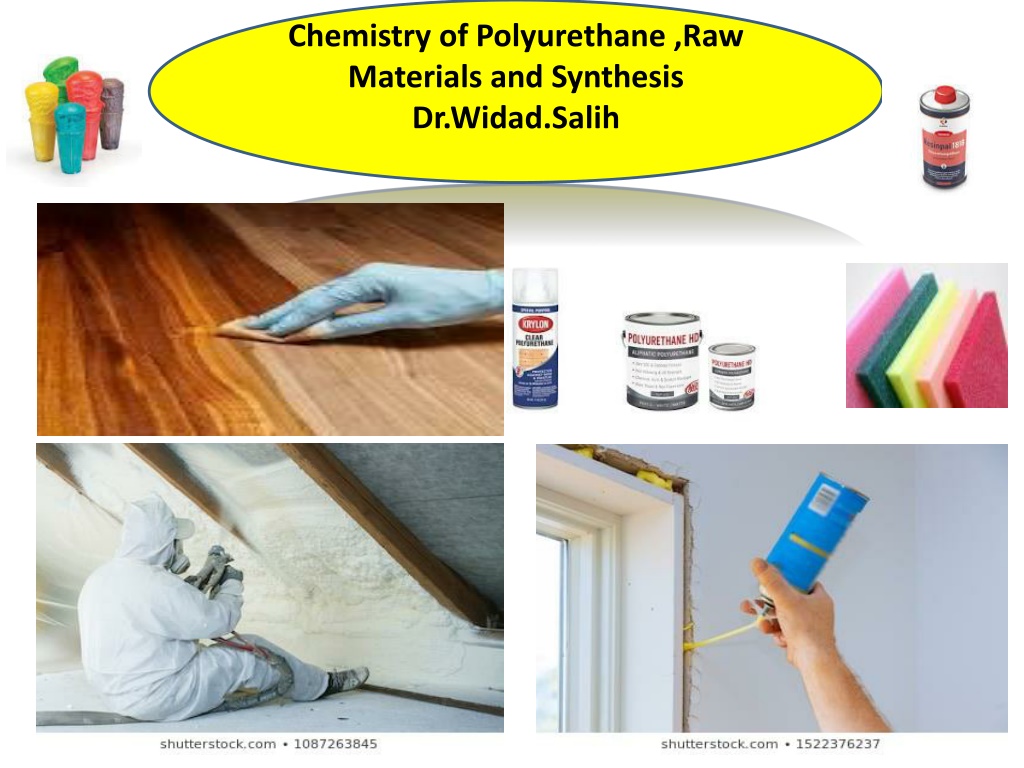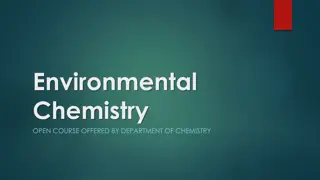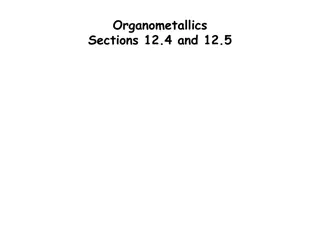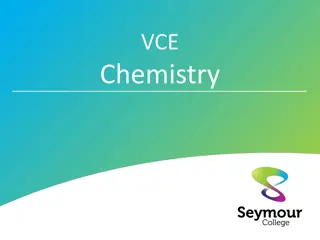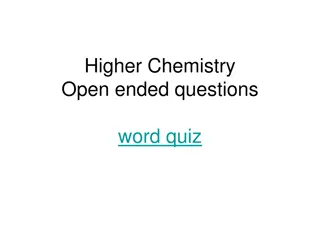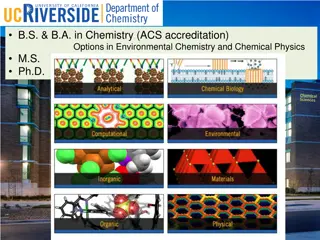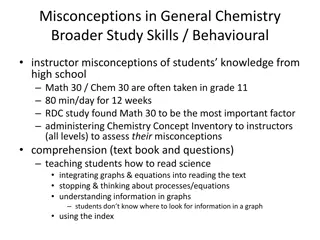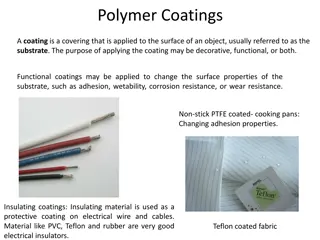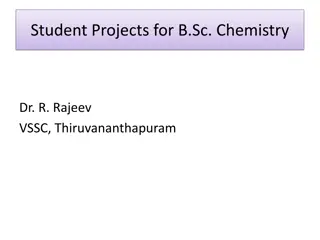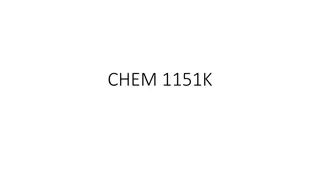Understanding the Chemistry of Polyurethane and Its Applications
Exploring the world of polyurethane from its raw materials and synthesis to its applications in different industries. Learn about the history, production process, types, and raw materials used in the creation of polyurethane products.
Download Presentation

Please find below an Image/Link to download the presentation.
The content on the website is provided AS IS for your information and personal use only. It may not be sold, licensed, or shared on other websites without obtaining consent from the author. Download presentation by click this link. If you encounter any issues during the download, it is possible that the publisher has removed the file from their server.
E N D
Presentation Transcript
Chemistry of Polyurethane ,Raw Materials and Synthesis Dr.Widad.Salih Image result for picture for polyurethane Image result for picture for polyurethane Image result for picture for polyurethane Image result for picture for polyurethane Image result for picture for polyurethane Image result for picture for polyurethane spray polyurethane foam for roof - technician spraying foam insulation using plural component gun for polyurethane foam, inside Hand holding polyurethane expanding foam glue gun applicator of windows with mounting foam
Types of Polyurethane Rigid Foam and Flexible Foam Pores Structure
Introduction Some years ago plastic industries were using different kinds of foam compositions to produce a variety of plastic products such as polyethylene and expanded polystyrene until they discovered polyurethane and that it could be altered in many different ways. Polyurethane was produced by the addition polymerization of different formulations between isocyanates and polyols to get the desired polymer. Additives were also used according to the process and type of product required. Foams are cushiony materials formed by the creation of gas bubbles in a base material such as natural rubber, synthetic rubber or other elastomeric materials. A plastic or also known as polymeric foam material consists of a gas phase dispersed in a solid plastic phase and derives its properties from both. The dispersed phase of the foam is usually called the internal phase (air or gases), whereas the continuous phase, external polymeric material)
During the late 1930s ,Otto Bayer and co-workers pioneered the chemistry of polyurethane . A Technology which led to the advent of polyurethane for a varity of applications . Since 1955 Mobay Corporation has introduced a variety of monomeric and polymeric isocyanates, like polyesters , polyether's , melamine and urea derivatives and acrylic polymers for use in the formulation of different types of polyurethane . Image result for picture for melamine polyurethane Acrylic PU paints Melamine PU polish
Raw Materials The raw materials used to prepared polyurethane was isocyanate compounds and polyol in addition with :- 1- Chain extender 2- Foaming agents 3- Foam stabilizer 4- pigments 5- Other additives, like fillers, light and thermal stabilizer ,antioxidant , antibacterial and so on .
Isocaynate Compounds TDI MDI HMDI MDCI
Polyisocyanates Adduct of TDI with TMP Isocyanurate trimer
Polyols Polyester-polyol
PU Chemistry The isocyanate group can react with any compound containing a reactive hydrogen .
Catalyst, Foaming agents, additives and some time used temp. This is the repeating unite for all PU , but the chemical structure of this repeating units depends on : - Chemecal structure of the isocyanate and polyol. - Some additives ,like chain extender or another reactive compounds.
How dose foam formation Polyurethane Foams can be accrued through two types of phenomena : 1- Chemical Foaming . 2- Physical Foaming. For chemical , water can be used in the reaction, it react with isocyanate group to formation of carbamic acid which unstable leading to formation of carbon dioxide and amine after decomposition
For physical foaming , low boiling point solvent can be used like chlorinated solvent , hexane or heptane , inert gas like argon or nitrogen or some chemical compounds which decompose during the reaction leading to formation gas, like AIBN Use of FHCs as physical blowing agents , carbon dioxide and HCs
The many attributes of a compound that must be considered while choosing a blowing agent include:- 1- Boiling points . 2-Mwt. 3-Vapour pressure in the temperature use. 4- Heat of vaporization . 5- Solubility in components and foams 6- Compatibility with materials . 7- Reactivity . .. -- The advantage of HCs over FHCs because of :- 1- low coast. 2- ready available . 3- free halogen . 4- zero ODP ( ozone depletion potential ).
Cross-linking reaction in the synthesis of PU
When the isocyanate groups react with alcohol ( the essential reaction ) , the reaction is exothermic and reversible , so amine , urea, amide and urethane linkage are formed.
allophate buiret
Oligomerization Isocyanates also react among each other under specific conditions or if special catalyst such as trialkylphosphines .In these reactions , products such as isocyanurates ( trimers ), uretdiones (dimers ) or carbodiimides are formed.Isocyanates undergo cyclo-addition reaction across two
OH Crosslinking /Chain extender The cross linking density of polyurethane can be controlled using chain extender and its property thereby influence NH Crosslinking /Chain extender
Catalysts Catalysts have a key role in PU production being required to maintain a balance between the reaction of isocyanate and polyol .So there are several catalysts used in the polyurethane synthesis , the most are tin octate and ter. amine catalyst. For polyurethane foam , two type of reactions take place .The isocyanate- hydroxyl and the isocyanate water reaction.Hence two catalysts are necessary .Tin catalysts promote mainly isocyanate hydroxyl reaction and they are called gelation catalyst. In contrast , ter.amine catalyst accelerate the isocyanate water reaction, which generates carbon dioxide gas and they are called as blowing catalyst .A good balance of gelation vs. blowing agents results in open cell foams.A great amount of blowing results in collapsed foams and agreater amount of gelation results in closed cell foams and shrinkage. Q: Why we use ter.amine as catalyst.
One Component system With single component adhesives, the adhesive components are premixed in their final proportions. They are however chemically blocked. As long as they are not subjected to the specific conditions which activate the hardener they will not bond. They require either high temperature or substances or media (light, humidity) from the surroundings to initiate the curing mechanism. The containers in which this type of adhesive are transported and stored must be carefully chosen to prevent any undesired reactions. These adhesives are usually 100% solid systems. The six major sub-classes are: 1-Anaerobic 2- Cyanoacrylates 3- Heat Cure 4- Moisture Cure 5- Radiation Cure 6- Silicones
Q1-: By chemical equation show how to synthesis of unsaturated polyurethane from resorcinol . Q2-: explain why use Ter.amine in state of primary and secondary amines as catalyst in the synthesis of polyurethane . Q3-: Polyurethane prepared by addition and condensation polymerization. Q4-: Explain how the one component polyurethane be cured . Q5-: For physical foaming its preferred to use HCs compounds more thane CHCs compounds. Q6-: Explain by chemical equation the cross linking reaction accrued in the polyurethane synthesis. Q7-: What is the best characteristic phenomena for polyurethane synthesis.
Technician spraying foam insulation using Plural Component Gun for polyurethane foam - Repair tool in the white protect suit applies a construction foam from the gun to the roof of a warehouse. Using polyurethane foam at home.
